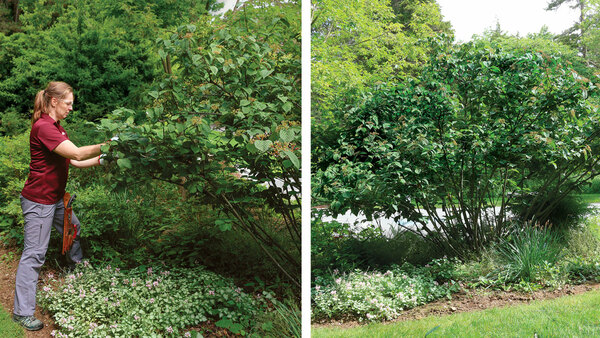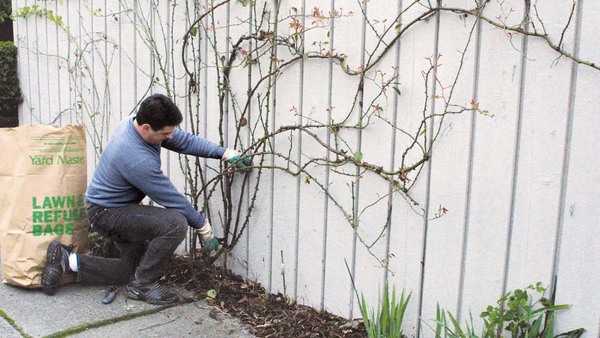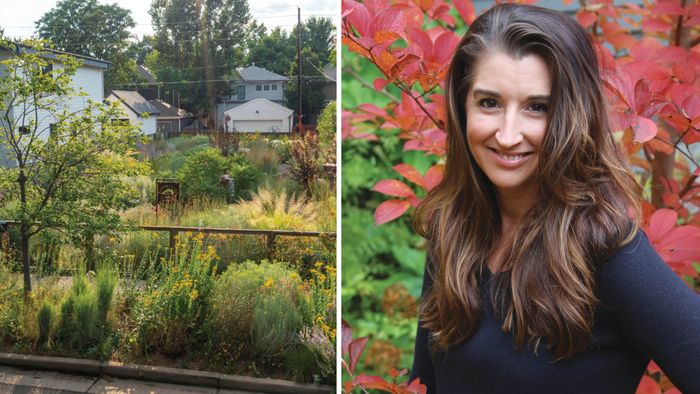
Despite erratic weather patterns in the Pacific Northwest during the cold months of the year, winter is an excellent time to take care of pruning your trees and shrubs. Early cold snaps and snow or extended mild temperatures can leave many of the plants feeling confused. In mild years, some deciduous woody plants can still have their leaves in mid to late December. But once the leaves are finally gone, and through late winter, it’s the perfect time to assess the shape of individual trees and shrubs and bust out your pruners, loppers, and even chainsaw for a little pruning. Below you’ll find some specialized pruning techniques that can help rejuvenate your plants and ensure that they grow well in the coming season.
Drastic measures: Winter is an excellent time for stooling
While there are several types of pruning styles and methods, winter is the best time for renovation pruning—hard or radical pruning done to tame or rejuvenate plants. The reason this timing is best is because the trees and shrubs are dormant, and they don’t respond with vigorous new growth after the winter pruning. Plus, the risk of insect pest and disease activity threatening the health of the plant is lower this time of year.
Good candidates for renovation pruning include those shrubs that sneak up on us. Sometimes we miss the obvious in our beds—like a shrub that looks beautiful one day and then suddenly seems to be overwhelming its neighbor. This is easy to see in winter. When you spot a shrub that has gotten out of control, the drastic method of pruning called “stooling” is sometimes needed. This is when you cut a shrub down to the ground.
During my winter assessment this year, I found in my garden a Ghost® weigela (Weigela florida ‘Carlton’, Zones 4–8) crowding a nearby ‘Susan’ magnolia (Magnolia ‘Susan’, Zones 4–8) and neighboring barberries (Berberis spp. and cvs., Zones 3–9). It was obviously time to stool-prune this multistemmed shrub. When stooling a shrub, I use a battery-operated chainsaw to cut the stems down to about 6 inches above the ground. When all the debris is removed, you can see the positive effect this pruning will have on the surrounding shrubs. This is also a good time to remove dead or crossing branches on those neighboring shrubs, which will respond by filling the open space with healthy new growth during the coming year.

Now is also a good time to deal with suckers
This time of year is also the best time to look for suckers on plants. Often you will see shoots coming from the bottom of a tree or single-stemmed shrub. These can be suckers below a graft (scion) from a root stock or from trees and shrubs that are prone to suckering. If a sucker is allowed to continue growing, it will overwhelm the main plant and often cause the desirable stems to die off. Suckers must be removed to maintain an uncluttered and sculptural plant. Lilacs (Syringa spp. and cvs., Zones 3–8) are a good example of suckering shrubs. They often make dense hedges if suckers are allowed to grow unhindered. Walk through your garden and look closely at the trunks of trees and shrubs for signs of suckering. Remove any suckers that can be pulled out by hand, as this will often remove the growth point from the main plant. If they are too large to pull off, use a saw or hand pruners (depending on the size of the sucker) to cut as close to the trunk or root as possible.

Lift-pruning: Look out for plants being crowded from above too
Another form of crowding to look for and address in winter is crowding at the base of trees and shrubs. Ground covers and smaller shrubs underneath some of the bigger shrubs and trees can often disappear if the larger woody plants are not kept in check by pruning up, or lift-pruning. Camellias (Camellia spp. and cvs., Zones 6–10) are a good example of shrubs that can have branches hanging down to the ground. By pruning off some of the lower branches, you provide space for smaller shrubs to grow and bloom. In my garden, I have several types of ferns in my camellia beds that benefit from lift-pruning, which gives them more light. The ferns also provide a wonderful texture as they fill in nicely beneath the large shrubs.
If you have fruit trees and roses, January and February are the best times to prune those plants in the Northwest. In general, though, a good rule of thumb for winter pruning is to do it before bud break. Also, don’t forget to clean up cuttings and leftover leaves, which will help with overall disease prevention in the spring and summer. For help with other pruning methods, a good pruning book is indispensable. You can also check out Fine Gardening’s Project Guide on Pruning, which is chock-full of pruning how-tos, tips, and resources.
—Susan Calhoun is the owner of Plantswoman Design in Bainbridge Island, Washington.
Photos: courtesy of Susan Calhoun
Fine Gardening Recommended Products

Sun Joe Cordless Telescoping Pole Chain Saw
Fine Gardening receives a commission for items purchased through links on this site, including Amazon Associates and other affiliate advertising programs.

VegTrug Classic Cold Frame
Fine Gardening receives a commission for items purchased through links on this site, including Amazon Associates and other affiliate advertising programs.

Gardener's Supply Company Summerweight Fabric Plant Cover
Fine Gardening receives a commission for items purchased through links on this site, including Amazon Associates and other affiliate advertising programs.



















Comments
Log in or create an account to post a comment.
Sign up Log in